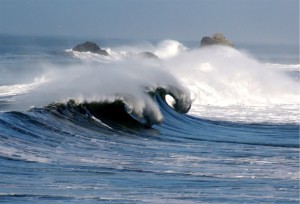On New Year’s Day, 1995, a freak wave hit the Draupner oil platform, 100 miles off the coast of Norway. Known as the ‘Draupner wave’, this was the first instrument-recorded rogue wave – waves that appear seemingly out of nowhere and pose a huge threat to anyone at sea. In oceanography, they are more precisely defined as waves that rise to twice the height of the others in a given sea state.
Despite their long history of destruction, before 1995 there had been only anecdotal evidence of these ‘monsters of the sea’ and they were considered near-mythical. However, their existence is now firmly accepted and recent research conducted by Günter Steinmeyer and colleagues at the Max Born Institute in Berlin, Germany, has revealed that it may even be possible to detect rogue waves before impact, providing up to 20 valuable seconds’ warning for those at risk.
This research could not only save lives, but also provide insight into a wide range of phenomena of a similar nature. Waves appear in almost every area of physics; in this case most notably in the quantum field. Steinmeyer’s research team investigated the determinism and predictability of rogue wave occurrences in three different rogue systems, of which one was oceanic but two were optical. They used nonlinear time series analysis methods to examine data from the Draupner incident, as well as from the infrared tail of optical fiber supercontinua and the fluence profiles of multifilaments.
Interestingly, they found that the systems had different degrees of determinism: oceanic rogue waves seem to have identifiable precursors, whereas their fibre-optic cable cousins are not at all deterministic. This is thought to be because the ocean waves are caused by turbulence, which is difficult to predict but not intrinsically random, whereas in optical fibres rogue waves are driven by quantum noise. According to Steinmeyer, “what this shows is really that ‘rogueness’ and predictability have nothing to do with each other.”
This work could provide insight into the predictability of a wide range of chaotic phenomena, as well as advance our understanding of the nature of quantum fluctuations and randomness.
![Rogue Waves Rock The Quantum Boat On New Year’s Day, 1995, a freak wave hit the Draupner oil platform, 100 miles off the coast of Norway. Known as the ‘Draupner wave’, […]](/wp-content/uploads/2012/12/News-image-01-300x1691.jpg)
